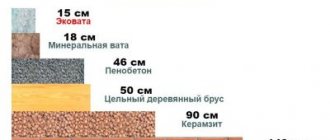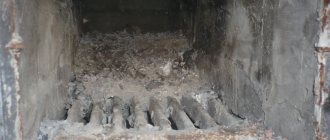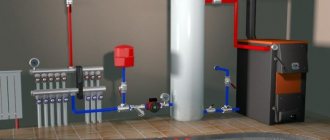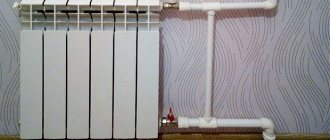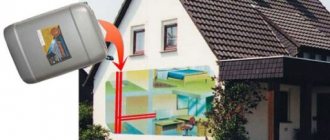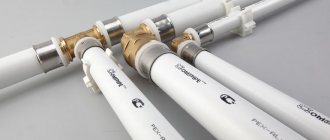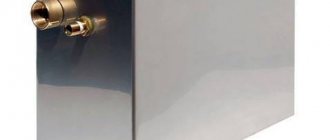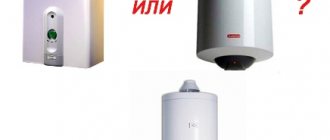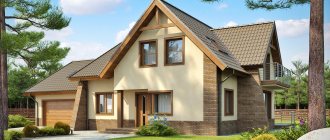Escaping from the bustle of the city, people try to buy or build a house away from civilization. But they are faced with the fact that often such remote places do not have a main gas pipeline and they have to look for ways that will ensure warmth and comfortable living in a country house. There are many options for heating a country house, but in this article we will answer the most important question that interests everyone without exception: what is the cheaper way to heat a house?
The following are the most popular types of fuel:
- The firewood is ordinary.
- Coal.
- Eurodrova.
- Electricity.
- Liquefied gas, in cylinders.
- Diesel fuel.
What kind of fuel will be appropriate in a particular building depends on the operating conditions of this building, the price of fuel and ease of use.
Conditions for choosing fuel:
- Fuel price.
- The price of the heating system and its installation.
- Heating system maintenance cost.
- Air temperature during the cold season in this region.
- Availability of communications.
- Possibility of fuel delivery.
- Purpose of the building: it is a place of permanent residence or a place of temporary residence for recreation or work.
- Presence of heat loss and degree of thermal insulation.
- Ease of operation of the heating and fuel system.
- Availability of a certain type of fuel in a given region.
To correctly select the most efficient type of fuel, it is necessary to carry out an appropriate calculation that will take into account the efficiency of a given heat source, heat loss, area and volume of the heated room.
All units of measurement must be reduced to a single denominator. It is most correct to use kilograms.
Comparative analysis of fuel used for a private home
To find out how cheaper it is to heat a house, you need to compare all available types of fuel.
Heating with regular wood
A simple, easily accessible heating method. It is especially beneficial if there is still a wood stove or stove (coarse) in the house. In this case, there is no need to install an additional heating system, if, of course, it copes with its functions. In another case, it is necessary to install a solid fuel boiler and install heating pipes.
If the house is located near a forest or planting, then it makes sense to use this particular heating method.
Pros and cons of solid fuel boilers
Advantages:
- Safety in operation subject to compliance with safety regulations.
- Versatility. Ability to use different types of fuel.
- Ability to re-equip the boiler for different operating conditions.
- In addition to heating the room, they can perform the function of heating water.
- Easy to use.
Flaws:
- Large mass, and in some cases large volume of the boiler.
- The boiler needs to be cleaned periodically, and this is a dirty and dusty job.
- It is necessary to monitor the availability of fuel and add it.
The main parameter is efficiency (efficiency factor), which in solid fuel boilers is 75%.
In addition to such boilers, there are modern solid fuel stoves or fireplaces that do not require the installation of a pipe system, but the heating volume is limited.
Firewood is the most easily accessible and cheapest type of fuel, however, if a large percentage of the population switches to heating with wood, then its cost will rise sharply.
Wood differs in the characteristics of its species and this affects its quality as fuel.
- Coniferous species (spruce, pine, cedar, thuja). Such firewood is characterized by a high resin content, which ensures a long combustion period with high heat release. But at the same time, the combustion of wood is accompanied by abundant smoke.
- Soft woods (willow, poplar, aspen, linden) burn quickly, emit little heat and do not generate heat, and are ineffective for heating.
- Hardwoods (oak, beech, hornbeam, elm, acacia, birch) are most effective. They burn for a long time, produce a large amount of heat and form a long-smoldering heat. Such rocks will provide consistently high temperatures for a long period of time.
Pros and cons of firewood as fuel
Advantages:
- Availability.
- Not a high price.
- Create a comfortable indoor microclimate.
- Independence from main communications.
Flaws:
- Additional storage space required.
- The need to regularly add firewood.
- The need to periodically clean the stove or boiler.
- A smoke exhaust pipe must be installed.
- Large labor costs (wood needs to be chopped and stacked).
Heating with eurowood
Eurofirewood is briquettes or pellets made from pressed dry wood of various species. Sawdust, shavings and other wood waste are pressed into a convenient shape. In the production of this type of fuel, no adhesive resins are used and, due to this, no soot is formed.
[direct]
Advantages of Eurowood:
- During combustion, a large amount of heat is released, more than when using hardwood of the corresponding mass.
- Long burning time.
- Low moisture content.
- Convenient to fire in the oven.
- The level of carbon dioxide emissions is lower than in conventional firewood.
- After combustion, a small amount of waste remains.
The disadvantages include:
- Need for additional storage space.
- The boiler may need to be slightly re-equipped.
The quality of briquettes depends on the following factors:
- Press density.
- Absence of foreign impurities.
- Compliance with production technology.
- The degree of quality of production equipment.
The main advantage of such fuel is the preservation of the environment, in particular forests. In any area where wood is used for production, a lot of waste remains that can be used to heat the house.
Coal heating
Coal is widely used, especially in areas where there is no gas pipeline. Stone and brown coal are used to heat a private house. Hard coal is divided into gas, long-flame and anthracite. When long-flame coal and gas burn, a lot of smoke is released. Anthracite has a low level of humidity, which ensures the release of high temperatures during combustion.
Special boilers are used to burn coal. Their peculiarity is that in addition to coal, other types of solid fuel can be used.
Calculation table for choosing a modern coal boiler.
| Options | Meaning |
| Desired room temperature | 22 °C |
| Heating area | 200 m2 |
| Room height | 3m |
| Specific thermal characteristics of the building | 0,41 |
| The amount of heat released during combustion | 5.8 kW*kg |
| Boiler efficiency | 90 % |
Pros and cons of using coal
Advantages:
- Coal combustion takes much longer than wood combustion. Thanks to this, you will need to add fuel less often.
- Long process of heat release.
- Coal can be used in various heating systems.
- All types of coal are suitable for heating, but with varying efficiency.
Flaws:
- In the case of large coal fractions, they will need to be crushed.
- Coal dust pollutes the room.
- The boiler must be cleaned periodically.
- A special room for storing coal is required.
Heating with liquefied gas
If the delivery of liquefied gas cylinders to a given area is organized, then it is possible to use them to organize heating in the room. But the gas consumption is significant and a large number of cylinders are required.
There are the following ways to save gas:
- A modern boiler that stores thermal energy can reduce gas consumption by four times.
- If you install the cylinders side by side, you can save on the costs of pipe routing.
- Installing a timer that will reduce the room temperature to 15 °C at night can significantly save gas consumption.
- To free up space, it is advisable to install a gas tank on the site.
Heating with diesel fuel
In addition to all of the above, it is possible to use a diesel fuel boiler. In order to determine the feasibility of installing such a boiler, it is necessary to consider its qualities.
Pros and cons of diesel boilers
Advantages:
- High efficiency.
- A large assortment.
- Safer than gas.
- Minimal use of electricity, only for the operation of automatic devices.
Flaws:
- The smell of diesel fuel.
- You cannot use low-quality diesel fuel.
- High fuel consumption.
- High price.
Electric heating
Every locality is connected to the power supply and installing electric heating is the easiest way. This explains the popularity of this type of room heating.
The most popular types of electric heating:
- Electric heaters (convectors, infrared heaters).
- Electric boilers.
- Warm floors (cable, infrared film floors).
Advantages of electric heating:
- Easy to use.
- High efficiency.
- Does not create noise.
- Maximum accurate temperature control.
- No special room for storing fuel is required.
- No harmful substances are released during the heating process.
- Easy to install.
Disadvantages of electric heating:
- High consumption and high cost.
- If there is a power outage, the house will cool down.
- Old wiring may not be able to withstand it and will burn out due to high load.
- Convectors heat the air, and it takes a lot of time and expense to heat it. If the house is not thermally insulated, the heat will quickly leave the room.
- IR heaters heat the surface, and it is comfortable only within the range of the infrared lamp.
The problem of high energy consumption can be solved by installing infrared heated floors. It creates a comfortable microclimate at the height of human growth.
Basic heating options for a cottage 2. Gas holder
If there is no main gas, you can store liquefied gas. Many do this, although this method assumes that you will have a huge container of explosive liquefied gas constantly buried on your site. At a minimum, this requires a fairly large fenced area where nothing can be planted or built, and special security measures. In addition, an accessible source of liquefied gas is required with the possibility of delivery to the site.
The cost and efficiency of boilers for liquefied gas are approximately the same as for main gas. Installing a gas tank will cost about 400,000 rubles. In terms of 50 years, we get 800,000 rubles, or 16,000 rubles. in year.
If the cost of liquefied gas is 15 rubles per liter (with delivery within 100 km from a large city) and the specific heat of combustion of the propane-butane mixture is about 12.8 kW*h/l, we get the cost of 1 kW*h of heat at 1.23 rubles, which is equivalent to costs of 104,550 rubles. in year.
What's cheaper to heat a house? comparison table
Choosing the optimal method of heating a country house comes down to comparing all types of fuel and technical characteristics of heating systems.
Fuel comparison table:
| Heat source | Boiler efficiency | Calorific value 1 kg per kWh | Requirement for a house 100m2 | Costs per season |
| Firewood | 70 | 4,5 | 25000 | 25000 |
| Eurodrova | 70 | 5,5 | 25000 | 34000 |
| Pellets | 70 | 5,2 | 25000 | 33750 |
| Coal | 90 | 7,7 | 25000 | 29250 |
| Diesel fuel | 75 | 11,9 | 25000 | 71500 |
| Liquefied gas | 75 | 13 | 25000 | 65500 |
| Electricity. One tariff | 99 | 25000 | 112500 | |
| Electricity including night tariff | 99 | 25000 | 89131 | |
| Electricity. Two tariffs | 99 | 25000 | 59300 |
* — main gas was not taken into account in this calculation, since it is beyond competition.
After carrying out all the calculations and comparing the positive and negative aspects of all types of heating, we find out what is cheaper to heat a house and it turned out to be ordinary firewood. It is advisable to install two types of boilers. The one that is more profitable and convenient during a certain period will be used.
Basic heating options for a cottage 1. Main gas
This solution seems to be the simplest, but it can only be so if the site is initially gasified. Otherwise, the cost of laying the pipeline can range from 500 thousand to three million rubles per household: it all depends on the size of the village, the distance of the gas pipeline and other conditions.
Actually, gas is so far the cheapest type of fuel in Russia, but the ruble cost of its production is growing, and world prices are trending downward. Therefore, it is difficult to predict the situation for a long time. We proceed from the fact that an adequate calculation of the cost of heating involves an analysis of costs over a fairly long period of time, taking into account repair and operating costs. In particular, for a country house it is advisable to consider a 50-year operating period.
Let's assume that to heat a two-story cottage with an area of 300 m2 with a kitchen, you need an automatic boiler with a capacity of 15 kW.
The cost of such equipment from well-known manufacturers today is approximately 30,000 rubles. It needs to be changed once every 10 years, that is, in 50 years at today’s prices it will run up 150,000 rubles. Taking into account the cost of annual maintenance (approximately 5,000 rubles) - 400,000 rubles, or 8,000 rubles. in year.
With a cost of main gas of 5.14 rubles/m3 (for the Moscow region) and a specific heat of combustion of 33,500 kJ/m3, the cost of 1 kWh of heat will be no more than 59 kopecks (taking into account the real efficiency of the boiler, which is approximately 92%) . During the heating season, which, for example, in the Moscow region officially lasts 215 days, for a cottage with an area of 300 m2 the heat demand will be 85,000 kWh, which will cost approximately 50,300 rubles. In total, taking into account operating costs, we get 58,300 rubles.
In total, in the general case, we get 58,300 rubles. per year (provided that gas has already been supplied to the village).
Basic heating options for a cottage 5. Electric boiler
The cost of an automatic electric boiler with the power we need (30 kW) will be approximately 50 thousand rubles (it will have to be replaced every 10 years). You will also have to pay extra for additional input power, which is at least 10 thousand rubles per kilowatt (we take into account the most reasonable prices on the market). The total cost of connection will be 300 thousand rubles.
The cost of a kilowatt-hour of electricity in the Moscow region is 4.81 rubles/kWh, the boiler efficiency is 99%. In total, we get the annual cost of heating - 413,000 rubles.
And taking into account the cost of equipment - 424,000 rubles. in year.
Basic heating options for a cottage 4. Solid fuel
Firewood, pellets (briquettes) or coal can be used in this capacity. However, you need to understand that a solid fuel boiler is not fully automatic. This means that someone must always work as a fireman. In the case of pellet boilers, the level of automation is higher, but the level of danger of fuel fire is also higher.
This must also be taken into account when using coal boilers. Therefore, in both cases additional security measures will be required. The cost of equipment varies greatly. For example, a 15-kilowatt boiler with manual loading will cost about 25,000 rubles, but you are unlikely to enjoy the prospect of constantly running to the boiler room and adding firewood or coal by hand. A boiler with automatic fuel supply can cost from 100,000 (pellet) to 200,000 rubles. (carbonic). True, they all serve for 20–25 years.
As a result, operating a wood-burning boiler will cost 6,250 rubles. per year, automatic pellet - 10,000, and automatic coal - 15,000 (all taking into account the cost of annual maintenance).
The cost of fuel depends significantly on the region. For example, in the Moscow region, 1 cubic meter (on average 650 kg) of birch firewood at a wholesale price today will cost 1,400 rubles. (we believe that when ordering a large volume at once, delivery will be free), coal of acceptable quality - 6,000 rubles. per ton, fuel briquettes - at about the same price.
If we assume that the specific heat of combustion of wood is approximately 3.4 kWh/kg, coal - 7.5 kWh/kg and briquettes - 5.6 kWh/kg; that the efficiency of a wood-burning boiler is approximately 75%, and that of an automatic one is 80%; then we get the cost of 1 kWh of heat, respectively equal to 0.84, 0.64 and 0.85 rubles. (firewood, coal and briquettes). That is, heating with wood will cost 71,400 rubles per year, and heating with coal will cost 54,060 rubles. and briquettes - 72,420 rubles.
And taking into account operating costs: firewood - 77,650 rubles. in year; coal - 69,060 rub. in year; briquettes - 82,420 rub. in year.
Coal heating, as we see, is cheaper than heating with other types of solid fuel, but firewood has become more profitable than briquettes in 2021. But any solid fuel is more expensive than main gas.
